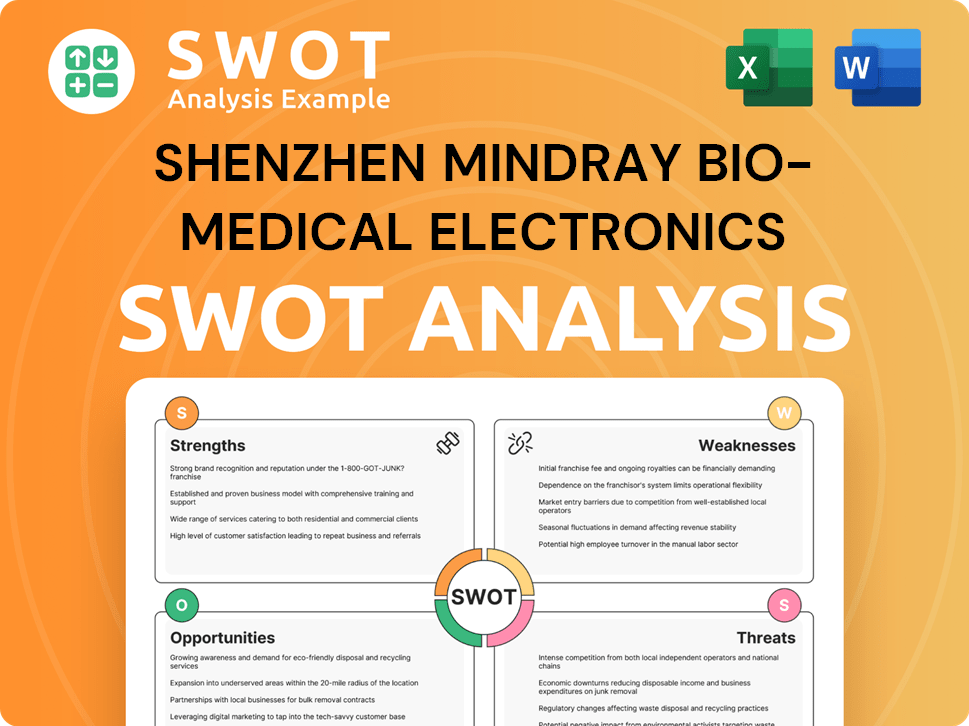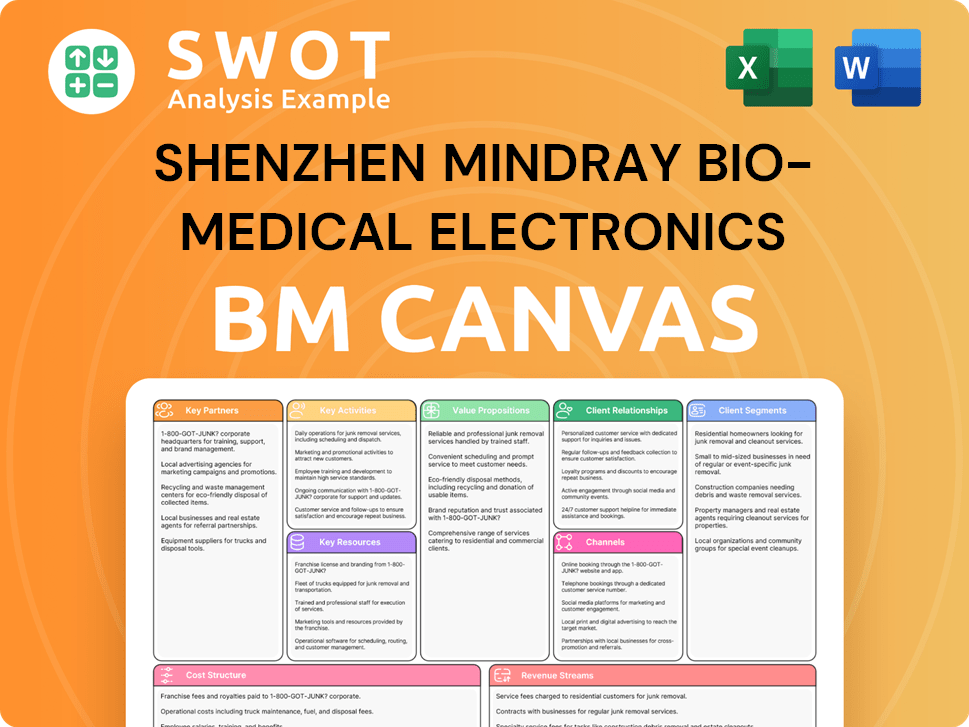Shenzhen Mindray Bio-Medical Electronics Bundle
How did Shenzhen Mindray Bio-Medical become a global leader?
Founded in 1991 in Shenzhen, China, Shenzhen Mindray Bio-Medical Electronics SWOT Analysis, or Mindray, embarked on a mission to revolutionize healthcare. From its humble beginnings, the Chinese medical device company has transformed into a multinational enterprise, driven by a commitment to innovation and global expansion. Its focus on delivering high-quality, cost-effective medical equipment has shaped its remarkable journey.

Mindray's story is one of impressive growth and adaptation within the bio-medical technology sector. Its core business spans patient monitoring, in-vitro diagnostics, and medical imaging, with products reaching over 190 countries. As of March 31, 2025, the company's financial performance, reflected in its $4.94 billion USD trailing 12-month revenue, highlights its significant impact on the medical industry and its continuous investment in research and development.
What is the Shenzhen Mindray Bio-Medical Electronics Founding Story?
The story of Shenzhen Mindray Bio-Medical Electronics Company began in 1991. It was a time of burgeoning technological advancement in China, and a group of visionary individuals saw an opportunity to revolutionize the medical device industry. Their goal was to create high-quality, affordable medical equipment to improve healthcare accessibility globally.
The company's establishment marked the beginning of a significant chapter in the history of the Chinese medical device industry. This initiative laid the groundwork for a company that would later become a global leader in its field. The founders' dedication to innovation and their understanding of market needs were key to Mindray's early success.
Mindray was founded in the Financial Center on Taizi Road, Shekou, Nanshan District, Shenzhen, China. The founding team comprised seven former employees of Anke, including Li Xiting, Xu Hang, and Cheng Minghe. The name 'Mindray' is a combination of 'mind' and 'ray,' symbolizing 'light of wisdom,' which reflects the company's focus on innovation and insight in the medical field.
Mindray's early growth was fueled by the development and provision of patient monitoring, imaging, and other diagnostic products within China. The company achieved significant milestones in its early years, contributing to China's medical technology advancements.
- In 1992, Mindray developed China's first blood oxygen saturation monitor.
- In 1993, the company launched the MEC-509, China's first self-developed multi-parameter patient monitor.
- Early funding was crucial; Walden International invested $2 million in 1997, followed by an additional $6 million from Walden International and other international venture capital funds in the same year.
The early focus on domestic market needs, combined with strategic investments, set the stage for Mindray's future expansion. The development of innovative products, like the MEC-509, demonstrated Mindray's commitment to research and development. The initial financial backing from Walden International and other venture capital firms provided the necessary resources to scale operations and pursue further innovation. This strategic approach, combining technological innovation with financial acumen, is a key aspect of Mindray's growth strategy.
Shenzhen Mindray Bio-Medical Electronics SWOT Analysis
- Complete SWOT Breakdown
- Fully Customizable
- Editable in Excel & Word
- Professional Formatting
- Investor-Ready Format

What Drove the Early Growth of Shenzhen Mindray Bio-Medical Electronics?
The early growth of Mindray Bio-Medical was marked by significant product development and market expansion. This phase saw the introduction of several 'firsts' in the Chinese medical device market, alongside strategic moves to enter international markets. The company's focus on innovation and global presence laid the groundwork for its future success in the medical equipment industry.
Following the launch of its initial patient monitor in 1993, Mindray History expanded its product line. In 1998, it introduced China's first portable multi-parameter patient monitor and semi-automatic 3-part hematology analyzer. These early innovations showcased the company's commitment to providing advanced medical solutions.
A pivotal step in 2000 was obtaining CE Mark certification, enabling Mindray Shenzhen to meet international export standards. This certification allowed the company to expand its market reach globally. This certification was crucial for its global expansion.
In 2002, Mindray's key milestones included launching China's first digital B/W ultrasound system and auto hematology analyzer. These advancements highlighted the company's continuous investment in bio-medical technology. The company consistently invested approximately 10% of its annual revenue in research and development.
The move to Hi-Tech Park in 2003 and the first FDA product certificate in 2004 marked further growth. The acquisition of Datascope's patient monitoring business in 2008 significantly boosted Mindray's global expansion, particularly in patient monitoring. To learn more about their strategy, read the Marketing Strategy of Shenzhen Mindray Bio-Medical Electronics.
Shenzhen Mindray Bio-Medical Electronics PESTLE Analysis
- Covers All 6 PESTLE Categories
- No Research Needed – Save Hours of Work
- Built by Experts, Trusted by Consultants
- Instant Download, Ready to Use
- 100% Editable, Fully Customizable

What are the key Milestones in Shenzhen Mindray Bio-Medical Electronics history?
The Shenzhen Mindray Bio-Medical Electronics Company, a significant player in the medical equipment industry, has achieved several milestones throughout its history. Its journey is marked by technological advancements, global expansion, and strategic acquisitions, solidifying its position as a leading Chinese medical device company. The company's evolution reflects its commitment to innovation and its ability to adapt to the dynamic healthcare market.
| Year | Milestone |
|---|---|
| 1993 | Mindray developed China's first self-developed multi-parameter patient monitor, marking a significant technological advancement. |
| 2002 | The company launched its first digital B/W ultrasound system, expanding its product portfolio in the medical equipment sector. |
| 2006 | Mindray was listed on the New York Stock Exchange, becoming the first Chinese medical device company to achieve this. |
| 2008 | Mindray acquired Datascope's patient monitoring business, strengthening its market position. |
| 2013 | The acquisition of ZONARE's imaging business in the U.S. expanded Mindray's global footprint. |
| 2018 | Mindray re-listed on the Shenzhen Stock Exchange after delisting from the NYSE. |
| 2021 | Mindray acquired HyTest, a leading diagnostic test material supplier, to enhance its in-vitro diagnostics capabilities. |
| 2023 | Mindray received two awards in the Product Launches category of the Medical Device Network Excellence Awards for its defibrillators and patient monitoring solutions. |
| 2024 | Mindray had applied for a total of 11,370 patents and received authorization for 5,588 as of December 31, 2024. |
Mindray's commitment to innovation is evident through its substantial investment in research and development. The company dedicates approximately 10% of its total revenue annually to R&D, leading to numerous patents and technological breakthroughs. Recent patent grants in late 2024 and early 2025 highlight innovations in ultrasound imaging, patient monitoring, and portable ultrasonic systems.
In 1993, Mindray developed China's first self-developed multi-parameter patient monitor, a key innovation. This marked a significant step in the company's early product development history.
The launch of the first digital B/W ultrasound system in 2002 expanded Mindray's product offerings. This innovation helped enhance the company's contributions to healthcare.
As of December 31, 2024, Mindray had applied for 11,370 patents. The company has received authorization for 5,588 patents, demonstrating its commitment to research and development.
The mWear system, recognized for its Anti-motion Algorithm, minimizes false alarms. This innovation was recognized with an award in 2023, showcasing Mindray's advancements in patient monitoring.
Mindray is integrating emerging technologies like AI through initiatives such as 'Intelli-Digital Transformation'. This focus enhances its medical equipment offerings.
Recent patent grants include innovations in shareable battery packs for portable ultrasonic systems. This highlights Mindray's focus on user-friendly designs.
Despite its successes, Mindray faces several challenges in the dynamic medical industry. These include navigating complex regulatory standards and ensuring data security for connected devices.
Mindray faces the complexities of technological innovation and integration into existing healthcare infrastructures. This requires continuous adaptation and investment in research and development.
Adherence to diverse and stringent regulatory standards across different regions poses a significant challenge. This impacts Mindray's global expansion and market share.
Market pressures, such as pricing pressure on IVD reagents and mid- to low-end medical equipment, affect profitability. Weak IVD testing demand in China in 2024 also poses a challenge.
Ensuring data management and security for increasingly connected medical devices is crucial. This is a key concern for Mindray's impact on the medical industry.
Domestic revenue decreased in 2024 due to weak hospital procurement and policy headwinds. This impacts the company's financial performance.
Mindray actively seeks substitutes for US-sourced raw materials to mitigate trade friction impacts. This is part of its corporate social responsibility.
For a deeper dive into Mindray's business model and revenue streams, explore the analysis of Revenue Streams & Business Model of Shenzhen Mindray Bio-Medical Electronics.
Shenzhen Mindray Bio-Medical Electronics Business Model Canvas
- Complete 9-Block Business Model Canvas
- Effortlessly Communicate Your Business Strategy
- Investor-Ready BMC Format
- 100% Editable and Customizable
- Clear and Structured Layout

What is the Timeline of Key Events for Shenzhen Mindray Bio-Medical Electronics?
The Mindray History showcases significant growth and innovation in the medical equipment sector. Founded in Shenzhen, China, the company has evolved from developing China's first self-developed multi-parameter patient monitor to becoming a global player. Key milestones include securing initial investment, obtaining CE Mark certification for international exports, and listing on the New York Stock Exchange. Strategic acquisitions, such as Datascope's patient monitoring business and ZONARE's imaging business, have broadened its portfolio. Mindray's transition back to the Shenzhen Stock Exchange and acquisitions like HyTest highlight its focus on the Chinese market and diagnostic materials. Recent financial results, including revenue of RMB 36.7 billion in 2024, demonstrate its continued success. The company's commitment to R&D and global market penetration drives its future outlook.
| Year | Key Event |
|---|---|
| 1991 | Founded in Shenzhen, China. |
| 1993 | Developed China's first self-developed multi-parameter patient monitor. |
| 1997 | Received first round of investment from Walden International. |
| 2000 | Obtained CE Mark certification, enabling international export. |
| 2002 | Launched China's first auto hematology analyzer. |
| 2006 | Listed on the New York Stock Exchange. |
| 2008 | Acquired Datascope's patient monitoring business in the U.S. |
| 2013 | Acquired ZONARE's imaging business in the U.S. |
| 2016 | Delisted from NYSE for re-listing in China. |
| 2018 | Re-listed on the Shenzhen Stock Exchange. |
| 2021 | Acquired HyTest, a diagnostic test material supplier. |
| 2024 | Reported revenue of RMB 36.7 billion (+5.1% YoY) and attributable net profit of RMB 11.7 billion (+0.7% YoY). Launched new solutions for mid-volume laboratories. |
| Q1 2024 | Achieved operating income of 9.373 billion yuan, an increase of 12.06% year-over-year, and net profit of 3.16 billion yuan, a 22.90% increase year-over-year. |
| Q3 2024 | Reported revenue of CN¥8.95 billion (up 1.4% from Q3 2023) and net income of CN¥3.08 billion (down 9.3% from Q3 2023). |
Mindray anticipates overseas revenue to grow by a mid-teens percentage in 2025. The company is targeting to be one of the top 20 global Medtech companies. This expansion is driven by strategic initiatives and market penetration.
Mindray expects a recovery in domestic medical equipment procurement in the second half of 2025. The company is focusing on accelerating breakthroughs with high-end customers in China. New healthcare infrastructure projects and equipment renewal policies present key opportunities.
Mindray is heavily investing in Intelli-Digital solutions, integrating AI to enhance diagnostic precision and operational efficiency. The company plans to complete the replacement of HyTest's raw materials by 2026, aiming for globally leading technical innovation in CLIA.
Mindray's future growth is driven by its commitment to R&D innovation. They are developing higher-performance reagents and imaging equipment. They are also focused on providing precise and easy-to-use minimally invasive devices.
Shenzhen Mindray Bio-Medical Electronics Porter's Five Forces Analysis
- Covers All 5 Competitive Forces in Detail
- Structured for Consultants, Students, and Founders
- 100% Editable in Microsoft Word & Excel
- Instant Digital Download – Use Immediately
- Compatible with Mac & PC – Fully Unlocked

Related Blogs
- What is Competitive Landscape of Shenzhen Mindray Bio-Medical Electronics Company?
- What is Growth Strategy and Future Prospects of Shenzhen Mindray Bio-Medical Electronics Company?
- How Does Shenzhen Mindray Bio-Medical Electronics Company Work?
- What is Sales and Marketing Strategy of Shenzhen Mindray Bio-Medical Electronics Company?
- What is Brief History of Shenzhen Mindray Bio-Medical Electronics Company?
- Who Owns Shenzhen Mindray Bio-Medical Electronics Company?
- What is Customer Demographics and Target Market of Shenzhen Mindray Bio-Medical Electronics Company?
Disclaimer
All information, articles, and product details provided on this website are for general informational and educational purposes only. We do not claim any ownership over, nor do we intend to infringe upon, any trademarks, copyrights, logos, brand names, or other intellectual property mentioned or depicted on this site. Such intellectual property remains the property of its respective owners, and any references here are made solely for identification or informational purposes, without implying any affiliation, endorsement, or partnership.
We make no representations or warranties, express or implied, regarding the accuracy, completeness, or suitability of any content or products presented. Nothing on this website should be construed as legal, tax, investment, financial, medical, or other professional advice. In addition, no part of this site—including articles or product references—constitutes a solicitation, recommendation, endorsement, advertisement, or offer to buy or sell any securities, franchises, or other financial instruments, particularly in jurisdictions where such activity would be unlawful.
All content is of a general nature and may not address the specific circumstances of any individual or entity. It is not a substitute for professional advice or services. Any actions you take based on the information provided here are strictly at your own risk. You accept full responsibility for any decisions or outcomes arising from your use of this website and agree to release us from any liability in connection with your use of, or reliance upon, the content or products found herein.